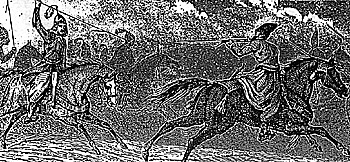 While heavily challenged by the well-organized and technologically superior Europeans on its western and northern borders, the Ottomans faced an entirely different situation in the east. Stretching along the frontier from the Persian Gulf to the Caucasus was Persia, the ancient enemy, with which the Ottomans had fought since the earliest days of the empire. The two had struggled for control of the Iran/Iraq border region since the Ottomans first arrived in the area in 1535.
While heavily challenged by the well-organized and technologically superior Europeans on its western and northern borders, the Ottomans faced an entirely different situation in the east. Stretching along the frontier from the Persian Gulf to the Caucasus was Persia, the ancient enemy, with which the Ottomans had fought since the earliest days of the empire. The two had struggled for control of the Iran/Iraq border region since the Ottomans first arrived in the area in 1535.
Persia was the most ancient and hated of the Ottoman enemies. More than a territorial war, the Persian-Ottoman conflict also had the trappings of a religious war. The Persians were Shiite Muslims while most people in the Ottoman Empire were Sunnis. Each considered the other to be heretics.
The Persians, therefore, sought to control the Ottoman region of Mesopotamia both because of the Shia holy places at An Najaf and Karbala and because Baghdad, the seat of the old Abbasid Empire and the home of the early Caliphs, had great symbolic value. The Ottomans, for their part, feared that Shia Islam would spread to Asia Minor and therefore sought to maintain the region as a Sunni-controlled buffer zone.
The major impact of the long and bloody Persian-Ottoman conflict for Mesopotamia had been the deepening of the Shia-Sunni rift. The region's Sunni population had suffered immeasurably during the extended Persian occupation in 1623-1638. As a result, during the Napoleonic era, the region's Shias were excluded from power altogether within the Ottoman Empire, and became politically impotent and economically depressed.
The almost constant warfare between the two empires in the 16th, 17th and 18th centuries also served to weakened Ottoman control over its eastern provinces allowing the growth of tribal authority. In the south, Bedouin raids into settled areas became increasingly difficult to control. Along the Persian frontier, the Kurds gained such independence that even nominal suzerainty was often lost.
As discussed in the accompanying article, the last great war between the Ottomans and Persians was the bloody and protracted war of 1723-1746. During the Napoleonic era this ancient warfare had more or less died down because of the chaos of the Persian civil war between Agha Mohammed Khan, the founder of the Kadjar dynasty, and Lutf Ali Khan, the last prince of the Zand dynasty. After Mohammed's victory in 1795, most of Persia's energy was taken up with renewed fighting against the Russians over Georgia. War would not break out between the Ottomans and the Persians again until 1820.
Armed and Armored
Throughout this period Persia was even more technologically backward then the Ottomans, still fighting in the style of the Middle Ages and early Renaissance. The result of this technological backwardness was that modern weapons were much less common throughout this region and even during the Napoleonic era personal armor still played an important part for the warriors of this area. The farther one went east in the Ottoman Empire, the heavier the armor, with troops on the extreme eastern frontier often dressed in full armor and riding armored horses, not unlike the later period of the old Byzantine Empire.
The Persian armies of the period featured great hordes of irregular cavalry and infantry, mostly recruited at the province and clan level, although there was a small professional army and artillery force maintained by the Shah. When fully mobilized, the Persians could easily put 200,000 troops in the field. Unit strength varied enormously, but tended to collect into commands of about 800 to 1,000 men each. Afghan cavalry units often served with the Persians as mercenaries.
Like the Ottomans, the Persian feudal forces wore no set uniform, instead dressing in their distinctive native costumes which tended to vary from north to south. In the northern and central regions the tall black felt or lambskin cap was the norm. In the south, especially along the Persian Gulf, Arabic dress, featuring turbans, gowns, loose shirts and trousers, was more common. Tall boots were the normal footwear and beards were universal.
Related
Back to Dragoman Vol. 2 No. 1 Table of Contents
Back to Dragoman List of Issues
Back to MagWeb Magazine List
© Copyright 1997 by William E. Johnson
This article appears in MagWeb (Magazine Web) on the Internet World Wide Web. Other military history articles and gaming articles are available at http://www.magweb.com